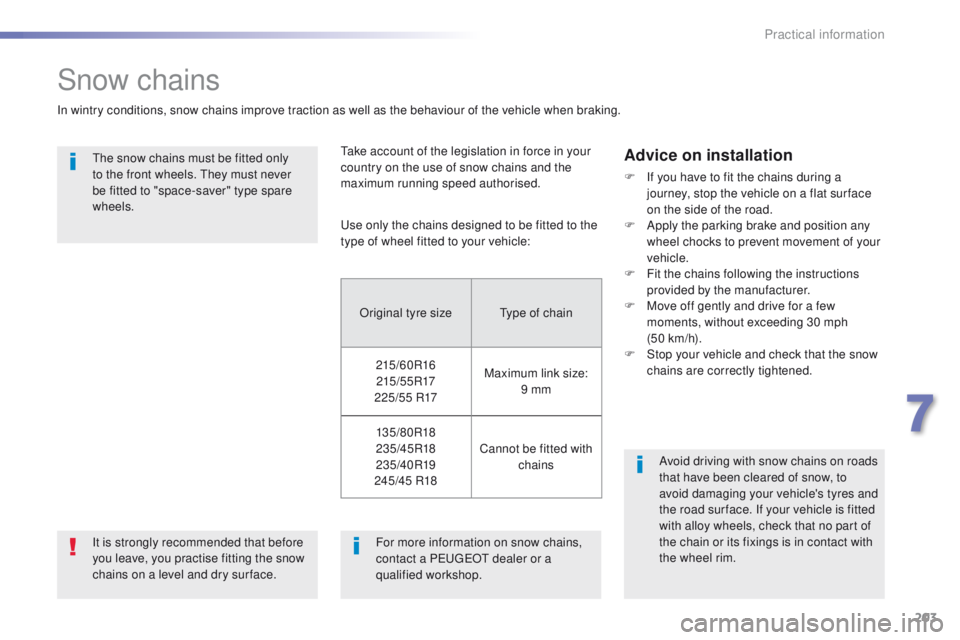Page 205 of 371

203
508_en_Chap07_info-pratiques_ed01-2016
Snow chains
In wintry conditions, snow chains improve traction as well as the behaviour of the vehicle when braking.
th
e snow chains must be fitted only
to the front wheels.
t
h
ey must never
be fitted to "space-saver" type spare
wheels.
us
e only the chains designed to be fitted to the
type of wheel fitted to your vehicle:
Advice on installation
F If you have to fit the chains during a journey, stop the vehicle on a flat sur face
on the side of the road.
F
A
pply the parking brake and position any
wheel chocks to prevent movement of your
vehicle.
F
F
it the chains following the instructions
provided by the manufacturer.
F
M
ove off gently and drive for a few
moments, without exceeding 30 mph
(50
km/h).
F
S
top your vehicle and check that the snow
chains are correctly tightened.
Avoid driving with snow chains on roads
that have been cleared of snow, to
avoid damaging your vehicle's tyres and
the road sur face. If your vehicle is fitted
with alloy wheels, check that no part of
the chain or its fixings is in contact with
the wheel rim.
For more information on snow chains,
contact a P
e
uge
Ot
dealer or a
qualified workshop.
It is strongly recommended that before
you leave, you practise fitting the snow
chains on a level and dry sur face.
ta
ke account of the legislation in force in your
country on the use of snow chains and the
maximum running speed authorised.
Original tyre size
ty
pe of chain
215/60R16 215 / 5 5 R17
225/55 R17 Maximum link size:
9 mm
13 5 /8 0 R18
235/45R18
235/40R19
245/45 R18 Cannot be fitted with
chains
7
Practical information
Page 275 of 371
273
508_en_Chap09_caracteristiques-techniques_ed01-2016
Identification markingsVarious visible markings for the identification of your vehicle.
A.
V
ehicle Identification Number (VIN)
under the bonnet.
t
h
is number is engraved on the bodywork
near the damper mounting.
th
e tyre pressures must be checked
when the tyres are cold, at least once
a month.
Low tyre pressures increase fuel
consumption.
B.
V
ehicle identification Number (VIN) on
the windscreen lower crossmember.
t
h
is number is given on a self-adhesive
label which is visible through the
windscreen. C.
M
anufacturer's label.
t
h
e VIN is marked on a self-destroying
label affixed to the door aperture, on the
driver's side.
D.
T
yre/paint label.
t
h
is label is fitted to the middle pillar, on
the driver's side. It bears the following information:
-
t
he tyre inflation pressures with and without
load,
-
t
he tyre sizes,
-
t
he inflation pressure of the spare wheel,
-
t
he paint colour code.
9
technical data
Page 367 of 371

4
Technical data
508-additif_en_Chap09_caracteristiques-techniques_ed01-2016
I d e n t i fi c a t i o n m a r k i n g s Various visible markings for the identification of your vehicle.
A. Vehicle Identification Number (VIN) under the bonnet. This number is engraved on the bodywork near the damper mounting.
The tyre pressures must be checked when the tyres are cold, at least once a month.
Low tyre pressures increase fuel c o n s u m p t i o n .
The original tyres fitted to the vehicle may have a load index or speed rating higher than those given on the label; this has no effect on the inflation pressures.
B. Vehicle identification Number (VIN) on the windscreen lower crossmember. This number is given on a self-adhesive label which is visible through the windscreen.
C. Manufacturer's label. The VIN is marked on a self-destroying label affixed to the centre pillar, on the left-hand or right-hand side.
D. Tyre/paint label. This label is fitted to the middle pillar, on the driver's side.
It bears the following information: - the tyre inflation pressures with and without load, - the tyre sizes, - the inflation pressure of the spare wheel, - the paint colour code.